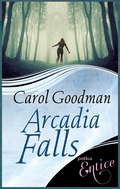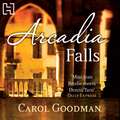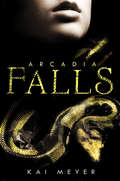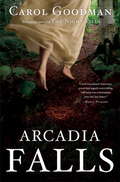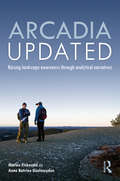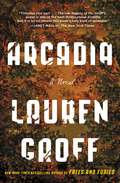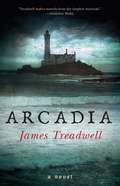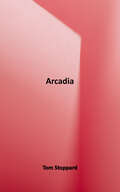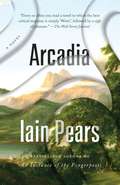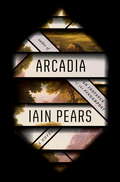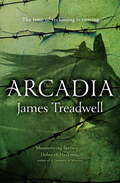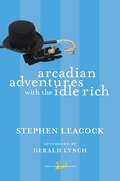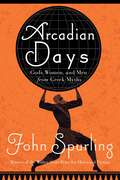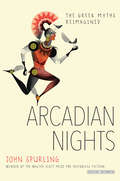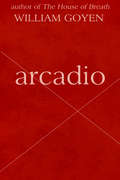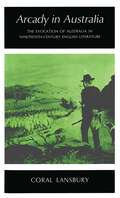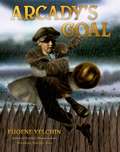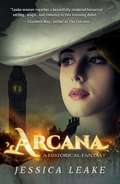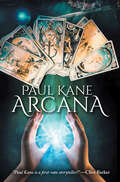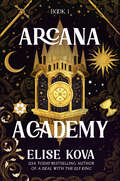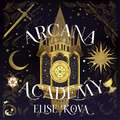- Table View
- List View
Arcadia Falls
by Carol GoodmanFor two hundred years, painters, poets and musicians have come to the Catskill Mountain village of Arcadia Falls to escape the pressures of modern life and pursue their artistic visions, and Arcadia College was founded with a mission to nurture young artists and writers. When Meg Rosenthal gets an offer to teach at Arcadia College, it seems a godsend - an escape from a life that's fallen apart. She hopes, too, that Arcadia Falls will be a place where she and her daughter Sally can find some peace and reconciliation. But even though Arcadia Falls proves to be even more beautiful then Meg imagined, it is hardly peaceful. Soon she begins to realize that the public story behind the school conceals deceit, betrayal, and perhaps even murder. As Meg struggles to reconcile the choices she's made in her own life, she begins to fear that by coming to Arcadia Falls she's put herself and her daughter in danger.
Arcadia Falls
by Carol GoodmanFor two hundred years, painters, poets and musicians have come to the Catskill Mountain village of Arcadia Falls to escape the pressures of modern life and pursue their artistic visions, and Arcadia College was founded with a mission to nurture young artists and writers. When Meg Rosenthal gets an offer to teach at Arcadia College, it seems a godsend - an escape from a life that's fallen apart. She hopes, too, that Arcadia Falls will be a place where she and her daughter Sally can find some peace and reconciliation. But even though Arcadia Falls proves to be even more beautiful then Meg imagined, it is hardly peaceful. Soon she begins to realize that the public story behind the school conceals deceit, betrayal, and perhaps even murder. As Meg struggles to reconcile the choices she's made in her own life, she begins to fear that by coming to Arcadia Falls she's put herself and her daughter in danger.
Arcadia Falls
by Kai MeyerRomeo and Juliet meets The Godfather amid an exotic Sicilian setting--filled with shape-shifters and mortal danger--in this thrilling conclusion to the first YA trilogy by bestselling German author Kai Meyer.Everyone close to mafia clan leader Rosa Alcantara is dead.Everything she's ever known about her life is a lie.Everywhere she turns there is a trap.As the clock ticks down to their own destruction, it's a race against time for young lovers Rosa and Alessandro as they evade murderers, track down clues, and avoid a showdown with the man who wants them dead.The pair must find out the truth behind Arcadia once and for all--but will it be the key to unlocking their freedom and future together, or the final step in bringing them to their knees?
Arcadia Falls: A Novel
by Carol GoodmanFinancial straits and a desire for a fresh start take recently widowed Meg Rosenthal and her aloof teenage daughter, Sally, to Arcadia Falls, a tucked-away hamlet in upstate New York where Meg has accepted a teaching position at a boarding school. The creaky, neglected cottage they'll be calling home feels like an ill omen, but Meg is determined to make the best of it. Then a shocking crisis strikes: During Arcadia's First Night bonfire, one of Meg's folklore students plunges to her death in a campus gorge. Sheriff Callum Reade finds the presumed accident suspicious, but then, he is a man with a dark past himself. Meg is unnerved by Reade's interest in the girl's death, and as long-buried secrets emerge, she must face down her own demons and the danger threatening to envelop Sally. As the past clings tight to the present, the shadows, as if in a terrifying fairy tale, grow longer and deadlier. Look for special features inside. Join the Circle for author chats and more. RandomHouseReadersCircle. com
Arcadia Updated: Raising landscape awareness through analytical narratives
by Marius Fiskevold Anne Katrine GeelmuydenArcadia Updated delves into the concept of landscape as it is shaped by the literary tradition and material works known as pastoral. Referring to several of the tradition’s works as well as scholarly critiques, Fiskevold and Geelmuyden highlight how individual landscape perception is primarily a cultural construct: each individual may see a unique landscape based on personal experiences, but simultaneously, landscape represents a tradition of engaging with nature and land, which has been largely forgotten. In re-engaging and connecting the practice of understanding landscapes with the pastoral tradition, the authors establish a common ground for treating landscape as an object of analysis in landscape planning. Arcadia Updated contributes to the methodological debate concerning landscape character assessment. Including 30 black-and-white images, this book analyses how humans engage with land organically, materially and communicatively. It seeks to raise landscape awareness as both an individual and a collective act of imagination. The practice of analysing landscapes is an ongoing culture of reinterpreting the land as landscape in response to society’s development and technical progress. The role of the landscape analyst is to interpret the contemporary world and offer visual explanations of it. This book will be beneficial to professional landscape planners as well as to academics and students of landscape, literature and cultural studies. It provides an essential contribution to the cross-disciplinarity of the landscape discourse.
Arcadia-Con (Tales of Arcadia: 3Below)
by Richard Ashley HamiltonFrom the limitless imagination of acclaimed filmmaker Guillermo del Toro and DreamWorks Animation, get ready to meet a new cast of otherworldly characters in 3Below—the exciting, new Tales of Arcadia series, which picks up where Trollhunters left off.For twins Aja and Krel being the new kids at school is hard. Honestly though, it’s high school. When isn’t there drama? But there may be a tad more drama than usual when you are teenage royals from another planet trying to blend in to the quiet little town of Arcadia Oaks, USA. In this first adventure of the Tales of Arcadia: 3Below series, Aja and Krel grudgingly attend Arcadia’s annual sci-fi/pop culture convention (Arcadia Con) and discover it’s easy to hide in plain sight when everyone is wearing a costume! The aliens meet up with Eli, Steve, Toby, Jim, and Claire from the Trollhunters series, who come in handy when an alien bounty hunter arrives at the convention to collect the bounty on Aja and Krel. Suddenly, Arcadia Con isn’t just fun and games. This book includes full-color glossy inserts with images from the show! DreamWorks 3Below © 2019 DreamWorks Animation LLC. All Rights Reserved.
Arcadia: A Novel
by Lauren GroffFrom the bestselling author of The Monsters of Templeton comes a lyrical and gripping story of a great American dream.In the fields of western New York State in the 1970s, a few dozen idealists set out to live off the land, founding what would become a commune centered on the grounds of a decaying mansion called Arcadia House. Arcadia follows this romantic, rollicking, and tragic utopian dream from its hopeful start through its heyday and after. Arcadia's inhabitants include Handy, a musician and the group's charismatic leader; Astrid, a midwife; Abe, a master carpenter; Hannah, a baker and historian; and Abe and Hannah's only child, the book's protagonist, Bit, who is born soon after the commune is created. While Arcadia rises and falls, Bit, too, ages and changes. If he remains in love with the peaceful agrarian life in Arcadia and deeply attached to its residents--including Handy and Astrid's lithe and deeply troubled daughter, Helle--how can Bit become his own man? How will he make his way through life and the world outside of Arcadia where he must eventually live?With Arcadia, her first novel since her lauded debut, The Monsters of Templeton, Lauren Groff establishes herself not only as one of the most gifted young fiction writers at work today but also as one of our most accomplished literary artists.
Arcadia: A Novel (Advent Trilogy Ser. #Bk. 3)
by James Treadwell"Magnificent." --Publishers Weekly (starred review) It's a year and a half after the events of Anarchy--a novel hailed as "bewitchingly perplexing and supernaturally entertaining" (Kirkus Reviews)--and the world is alive with magic in this third astonishingly imaginative novel in the fantasy trilogy that began with Advent.On a tiny archipelago out of sight of the rest of the world lives Rory, a ten-year-old boy. He and his mother and a handful of survivors live an exhausting and precarious existence, entirely isolated. The sea is alive, and angry. Every man Rory can remember has been drowned. Everyone knows he'll be next. One night, for the first time since the world changed and the curse descended, strangers appear on the island. They're on their way to England, seeking a powerful magic ring. And one of them seems to know Rory by sight... Caught up in their quest, Rory enters an England of terrors and marvels, at the heart of which lies a place where journeys unimaginably longer and older than his will reach their end: Pendurra.
Arcadia: A Play
by Tom StoppardThis play takes readers back and forth between the 19th and 20th centuries. Set in a large country house in Derbyshire, a cast of characters from each century play out their respective dramas.
Arcadia: A novel
by Iain PearsFrom the author of the international best seller An Instance of the Fingerpost, Arcadia is an astonishing work of imagination. In Cold War England, Professor Henry Lytten, having renounced a career in espionage, is writing a fantasy novel that dares to imagine a world less fraught than his own. He finds an unlikely confidante in Rosie, an inquisitive young neighbor who, while chasing after Lytten's cat one day, stumbles through a doorway in his cellar and into a stunning and unfamiliar bucolic landscape—remarkably like the fantasy world Lytten is writing about. There she meets a young boy named Jay who is about to embark on a journey that will change both their lives. Elsewhere, in a distopian society where progress is controlled by a corrupt ruling elite, the brilliant scientist Angela Meerson has discovered the potential of a powerful new machine. When the authorities come knocking, she will make an important decision—one that will reverberate through all these different lives and worlds.
Arcadia: A novel
by Iain PearsFrom the author of the international best seller An Instance of the Fingerpost, Arcadia is an astonishing work of imagination. In Cold War England, Professor Henry Lytten, having renounced a career in espionage, is writing a fantasy novel that dares to imagine a world less fraught than his own. He finds an unlikely confidante in Rosie, an inquisitive young neighbor who, while chasing after Lytten's cat one day, stumbles through a doorway in his cellar and into a stunning and unfamiliar bucolic landscape—remarkably like the fantasy world Lytten is writing about. There she meets a young boy named Jay who is about to embark on a journey that will change both their lives. Elsewhere, in a distopian society where progress is controlled by a corrupt ruling elite, the brilliant scientist Angela Meerson has discovered the potential of a powerful new machine. When the authorities come knocking, she will make an important decision—one that will reverberate through all these different lives and worlds.
Arcadia: A novel
by Iain PearsIn a major suspense novel set to surpass the internationally bestselling An Instance of the Fingerpost comes a dazzling story of youth, love and murderous ambition--a novel of time travel spanning three beautifully detailed worlds: the intellectual spires of Oxford in 1960, an ancient Arcadian world, and a dystopian future.In 1960, Henry Lytten is an Oxford don who dabbles in espionage and fiction writing. Rosie Wilson is the quick-witted, curious 15-year-old girl who feeds Professor Lytten's cat. Several hundred years in the future, living in a dystopian society on the Isle of Mull, is Angela Meerson--a brilliant psychomathematician who has discovered the world-changing potential of a powerful new machine. Somewhere, sometime, is Jay--a scholar's apprentice in an idyllic, pastoral land. Who these people really are, and how their stories come together, will be revealed in Iain Pears's fascinating great puzzle of a novel.
Arcadia: Advent Trilogy 3
by James TreadwellAll the men are dead - now it's the boys' turn. On a tiny archipelago, cut off from the rest of the world by a cursed sea, a handful of survivors live a precarious existence, clinging to their memories of the time before magic and their hope that those times will return.As far as he knows, Rory is the only boy left.Then the man comes, weaving his tales of a quest to find a powerful ring, and Rory finds himself embarking on a journey through terrors and marvels, once more in the world of men.And the moment of reckoning, when it comes, will bring an end to stories unimaginably older than his own.
Arcadia: Advent Trilogy 3
by James TreadwellAll the men are dead - now it's the boys' turn. On a tiny archipelago, cut off from the rest of the world by a cursed sea, a handful of survivors live a precarious existence, clinging to their memories of the time before magic and their hope that those times will return.As far as he knows, Rory is the only boy left.Then the man comes, weaving his tales of a quest to find a powerful ring, and Rory finds himself embarking on a journey through terrors and marvels, once more in the world of men.And the moment of reckoning, when it comes, will bring an end to stories unimaginably older than his own.
Arcadian Adventures with the Idle Rich: With A New Introduction By Ron Dart (New Canadian Library)
by Stephen Leacock Gerald LynchOf the many books by Canada's most celebrated humorist, none has received more acclaim than his brilliant, caustic treatment of the glittering rich who gather at the Mausoleum Club on Plutoria Avenue.Today, Leacock's pointed satire of the privileged class, and their social abuses and pretences, retains every ounce of its freshness and bite. An undisputed comic masterpiece, Arcadian Adventures with the Idle Rich reveals a depth of compassionate criticism rare in Leacock's writings. From the Paperback edition.
Arcadian Days: Gods, Women, and Men from Greek Myths
by John SpurlingA bold and dynamic retelling of five great male-female pairings from the Greek myths: Prometheus and Pandora, Jason and Medea, Oedipus and Antigone, Achilles and Thetis, and Odysseus and Penelope.Award-winning historical novelist and playwright John Spurling draws on his lifelong love and knowledge of Classical Greek drama and poetry to reanimate five great male–female storylines from the Greek myths. The Greek myths, refined by the great poets and playwrights of ancient Greece, distil the essence of human life: its brief span, its pride, courage, and insecurity, its anxious relationship with the natural world—earth, sea, and sky, represented by powerful gods and monsters. Taking inspiration from the incomparably beautiful and intense poetry of Homer, Aeschylus, Sophocles, and Euripides, John Spurling—a lifelong classicist and an award-winning playwright—spins five myths for contemporary readers. These captivating tales center on male-female pairs—Prometheus and Pandora, Jason and the sorceress Medea, Oedipus and his daughter Antigone, Achilles and his mother Thetis, Odysseus and Penelope—who, in the course of their stories, destroyed dynasties, raised and felled heroes, and sealed the fates of men.
Arcadian Nights: The Greek Myths Reimagined
by John SpurlingThe vibrant retelling of the central Greek myths by acclaimed novelist John Spurling, author of The Ten Thousand Things, winner of the 2015 Walter Scott Prize for Historical Fiction The classical Greek intellectual tradition pervades nearly every aspect of our modern Western civilization. Our logic and science, our philosophy, politics, literature, architecture, and art are all indebted to the ancient inhabitants of the small mountainous Mediterranean country. And the powerful myths of the Greeks, refined by Homer, Hesiod, Herodotus, and the great Greek dramatists, still resonate at the core of our culture. Taking as his starting point many of the famous tourist sites in the Peloponnese, where the stories are set, John Spurling, winner of the 2015 Walter Scott Prize for Historical Fiction, freshly imagines key narratives from the Greek canon, including tales of the doomed house of Atreus (notably Agamemnon, leader of the Greeks at Troy, murdered by his wife in his palace bathroom); of the god Apollo; goddess Athene; Theseus, scourge of the Minotaur; the Twelve Labors of Heracles; and Perseus, rescuer of Andromeda. In this vibrant, gripping and often grisly retelling of the Greek myths, stories of murder, power, revenge, love, and traumatic family relationships are made new again for our time with wit and relish by a gifted author. Spurling has added scene, dialogue, and context, while always staying true to the spirit of the original myth.
Arcadio
by William GoyenCompleted while he was dying, William Goyen's Arcadio is one of the most affecting and imaginative farewells to life ever written. Arcadio, whose voice is inimitably Goyenesque, is a creature from beyond the normal walks of life. Half man, half woman, raised in a whorehouse and for years the veteran exhibitionist in an itinerant circus sideshow, he has escaped from the show and has been wandering in a quest for his lost family. Speaking intimately to the reader, he tells the bizarre and fantastic tale of his life. This unforgettable novel is the crown of Goyen's exploration of the forms and feelings that could be compassed within fiction.
Arcady in Australia: The evocation of Australia in nineteenth-century English Literature
by Coral LansburyThis provocative book examines the vision of Australia in nineteenth-century English literature. The industrial revolution destroyed the myth of an idyllic rural way of life in England, and writers like Charles Dickens, Bulwer Lytton and Charles Reade created it anew in the improbable environment of Australia. The popular image of Australia in English literature was Arcadian; in turn it dominated the thought and traditions of writing in Australia. The man who supplied the material for English writers was Samuel Sidney; he was for a time regarded as an expert on Australia, although he had never set foot in the antipodes and all his material was second-hand. His influence on the literature of the period, and consequently on Australia, has received scant attention. Sidney's influence is fully examined; the book also offers entirely new material on Wakefield, Dickens, Lytton and Reade. It provides a new and challenging interpretation of literature and social history in both England and Australia.
Arcady's Goal
by Eugene YelchinWhen twelve-year-old Arcady is sent to a children's home after his parents are declared enemies of the state in Soviet Russia, soccer becomes a way to secure extra rations, respect, and protection but it may also be his way out if he can believe in and love another person--and himself.
Arcana
by Jessica LeakeA romantic, suspenseful, genre-bending debut set in Edwardian London.Amid the sumptuous backdrop of the London season in 1905, headstrong Katherine Sinclair must join the ranks of debutantes vying for suitors. Unfortunately for Katherine, she cannot imagine anything more loathsome--or dangerous. To help ease her entrance into society, Katherine's family has elicited the assistance of the Earl of Thornewood, a friend and London's most eligible bachelor, to be her constant companion at the endless fetes and balls. But upon her arrival in London, Katherine realizes there will be more to this season than just white gowns and husband hunting.Through her late mother's enchanted diary, Katherine receives warning to keep hidden her otherworldly ability to perform arcana, a magic fueled by the power of the sun. Any misstep could mean ruin--and not just for her family name. The Order of the Eternal Sun is everywhere--hunting for those like her, able to feed on arcana with only a touch of the hand.But society intrigue can be just as perilous as the Order. The machinations of the fashionable elite are a constant threat, and those who covet Katherine's arcana, seeking the power of her birthright, could be hiding behind the façade of every suitor--even the darkly handsome Earl of Thornewood.With so much danger and suspicion, can she give her heart to the one who captivates her, or is he just another after her power?
Arcana
by Paul Kane"Arcana is a hugely entertaining read, a real rollercoaster ride of ups and downs that keep the pages turning until the very end, and another work of high quality from this prolific author.&”—Starburst Magazine In an alternate world where real magic exists, its practitioners are hunted down by police officers called M-forcers. But some groups are fighting back! Callum McGuire is a new M-forcer who once worked the quiet streets of London. As an orphan, Callum has been brought up to believe that all magic is evil, but the more he sees of The M-forcers&’ cruel methods (implemented by General Nero Stark, and his second-in-command Sherman Pryce), the more he begins to question whether or not they are right. And when he unwittingly encounters a member of the rebel group called Arcana, he&’s introduced to their world and realises that nothing will ever be the same again. Join award-winning and bestselling author Paul Kane (the sell-out phenomenon Sherlock Holmes and the Servants of Hell, the Hooded Man series, and the bestselling Before) as he shows you a kind of magic you&’ve never seen…
Arcana Academy (Arcana Academy)
by Elise Kova&“Magical from nail-biting beginning to shocking end!&”—Danielle L. Jensen, #1 New York Times bestselling author of A Fate Inked in BloodA woman who wields magical tarot cards lands herself in a false engagement with the headmaster of a mysterious academy in this first installment of an enthralling fantasy romance series from the bestselling author of A Deal with the Elf King.Clara Graysword has survived the underworld of Eclipse City through thievery, luck, and a whole lot of illegal magic. After a job gone awry, Clara is sentenced to a lifetime in prison for inking tarot cards—a rare power reserved for practitioners at the elite Arcana Academy.Just when it seems her luck has run dry, the academy&’s enigmatic headmaster, Prince Kaelis, offers her an escape—for a price. Kaelis believes that Clara is the perfect tool to help him steal a tarot card from the king and use it to re-create an all-powerful card long lost to time.In order to conceal her identity and keep her close, Kaelis brings Clara to Arcana Academy, introducing her as the newest first-year student and his bride-to-be.Thrust into a world of arcane magic and royal intrigue, where one misstep will send her back to prison or worse, Clara finds that the prince she swore to hate may not be what he seems. But can she risk giving him power over the world—and her heart? Or will she take it for herself?Book One of The Arcana Academy Series
Arcana Academy: an enthralling, addictive, unputdownable fantasy romance (Arcana Academy)
by Elise KovaClara Graysword has survived the underworld of Eclipse City through thievery, luck, and a whole lot of illegal magic. After a job goes awry, Clara is sentenced to a lifetime in prison for inking tarot cards - a rare power reserved for practitioners at the elite Arcana Academy. Just when it seems her luck has run dry, the academy's enigmatic headmaster, Prince Kaelis, offers her an escape - for a price. Kaelis believes that Clara is the perfect tool to help him steal a tarot card from the king and use it to re-create an all-powerful card long lost to time. In order to conceal her identity and keep her close, Kaelis brings Clara to Arcana Academy, introducing her as the newest first-year student and his bride-to-be. Thrust into a world of arcane magic and royal intrigue, where one misstep will send her back to prison or worse, Clara finds that the prince she swore to hate may not be what he seems. But can she risk giving him power over the world - and her heart? Or will she take it for herself?
